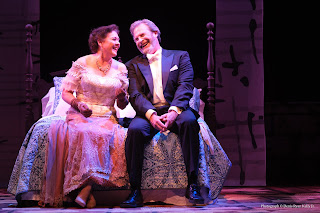ISO puts piece by living American in privileged position among two Russians
It must be a first for a substantial 21st-century work to lead off an Indianapolis Symphony
 |
| Daniel Raiskin guest-conducts again today. |
Orchestra Classical Series program.
That's the case this weekend with guest conductor Daniel Raiskin's illuminating commnad of Julia Wolfe's "Pretty." Heard Friday night at Hilbert Circle Theatre, the challenging 20-minute work made for more than a curtain-raiser ahead of Shostakovich's Piano Concerto No. 2, op. 102, and Tchaikovsky's Suite No. 3 in G major.
I'm not sure I was supposed to recall immediately the line from "T'he Wizard of Oz" that the Wicked Witch of the West directs at the frightened Dorothy: "I'll get you, my pretty, and your little dog, too." The composer's program note triggered it with a sentence beginning: "My Pretty is a raucous celebration — embracing the grit of fiddling, the relentlessness of work rhythms, and inspired by the distortion and reverberation of rock and roll."
 |
| Julia Wolfe draws on several sources of musical energy. |
In those words, Wolfe has crafted here a concise verbal description of her work, which premiered in Berlin in June 2023. The piece itself unleashes a torrent of pulsating energy, with only momentary relief, as it makes something ceaselessly interesting out of its full-bore exploitation of the symphony orchestra in terms shaped by vernacular styles.
Margaret Hamilton's line as the Oz version of an unneighborly crone in a farm girl's life shook me as a grade-school kid seeing the 1939 movie in a theater. On the big screen is where "The Wizard of Oz" recirculated in the 1950s before it became repeatedly available on television.
It took me several years to realize that real tornadoes don't pick up farmhouses and whirl them around intact in the air before subsiding. But I had a mean third-grade teacher who once washed my mouth out with soap after she overheard me tell a classmate I had just drawn a picture of a "devil." So I knew that meanness is no fantasy.
Many layers of fantasy can be detected in "Pretty," along with the movie script's hint that the Witch is jealous of the fact that Dorothy is truly pretty. In the music, there are swoops often into what could be taken as qualities that define prettiness. The recurrent glissandos often underline the irony inherent in how the word is used, especially as an adverb. Everybody knows that "pretty ugly" is not a contradiction in terms, for instance.
I like that Pretty retains the relentless forward motion with which it gets under way. But the variety it enfolds makes the composition go by pretty fast. I never got the feeling that my ears were being slugged into acceptance. Raiskin seemed a trusty guide to its variety, its rocking out, as certain as was needed to put it across. The work's peculiar charm puts it up there with another of my Wolfe favorites, "Weird Sister."
My dread of the long work on the program, the Tchaikovsky suite, receded somewhat after Wolfe's music made its attractive points under his baton. It's still likely that the Russian composer's Suite No. 3 will appeal mainly to confirmed Tchaikovsky fans. Friday night's performance leaned into the emotional appeal and cunning writing for winds (who deserved the group bow Raiskin signaled for them to take at the end).
The rhythmic precision in the Scherzo was mostly true. The Russian-born conductor, now music director of the Winnipeg Symphony, clearly admires this music and engages with its heart-on-sleeve quality. The ISO musicians are primed to respond alertly to such direction.
 |
| Dejan Lazic has played both Shostakovich piano concertos here. |
Thus, a peasant dance follows a variation in the Baroque style; then comes another peasant dance, which leads to a solo violin cadenza that shapes another variation with the solo violin accompanied by colleagues (Kevin Lin gave an enchanting account Friday).
And no one could whip up a frothy topping better than Tchaikovsky does here to end the indulgence. He wrote thrillingly from his nerve endings, and I'll admit that's been a widely acquired taste across the world's concert stages for nearly a century and a half.
On the prior side of intermission came the trim three movements of the Shostakovich concerto, starring the return of guest solo pianist Dejan Lazic, who was a favorite of the ISO's seventh music director, Krzysztof Urbanski.
Lazic knows how to beguile an audience, as was evident from the piano's immediate entrance. The delicate second movement had him casting the requisite spell, even if at one point the held horn note in the background faltered slightly.
The finale made its mark with the kind of sparkle Shostakovich could usually rein in better than his esteemed predecessor. Brought back for an encore, Lazic offered the first Fantastic Dance, op. 5, by the teenage Shostakovich. It's a product of the deceptively open-hearted aesthetic of the early Soviet era, and rests upon the way Russian classical music came of age under the tsarist regime.


Comments
Post a Comment